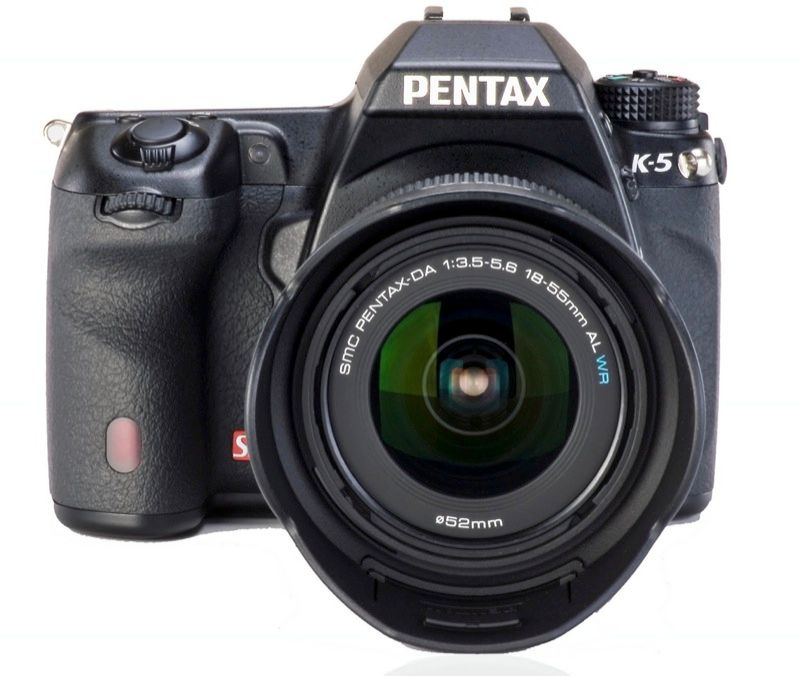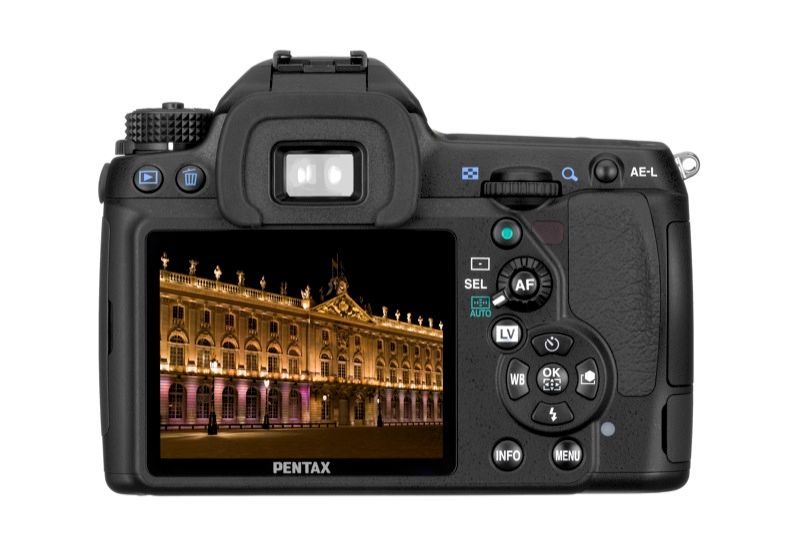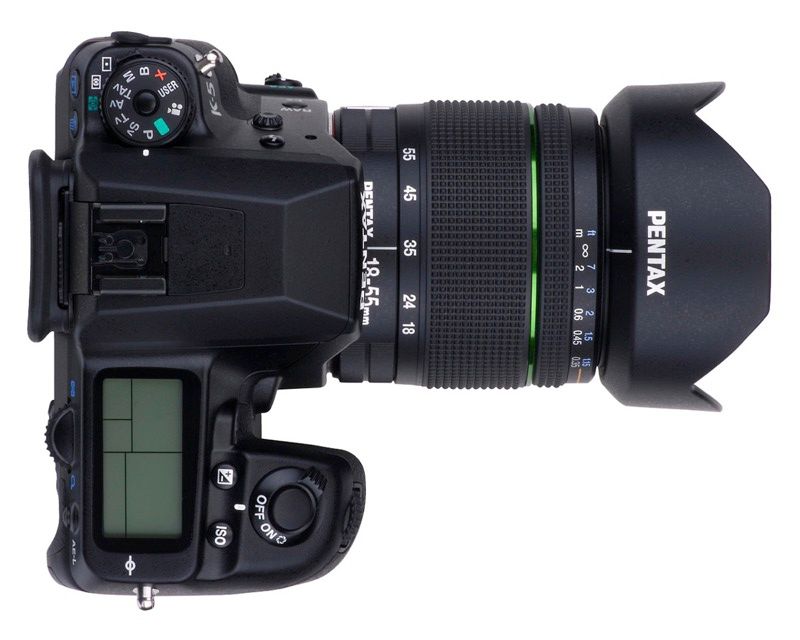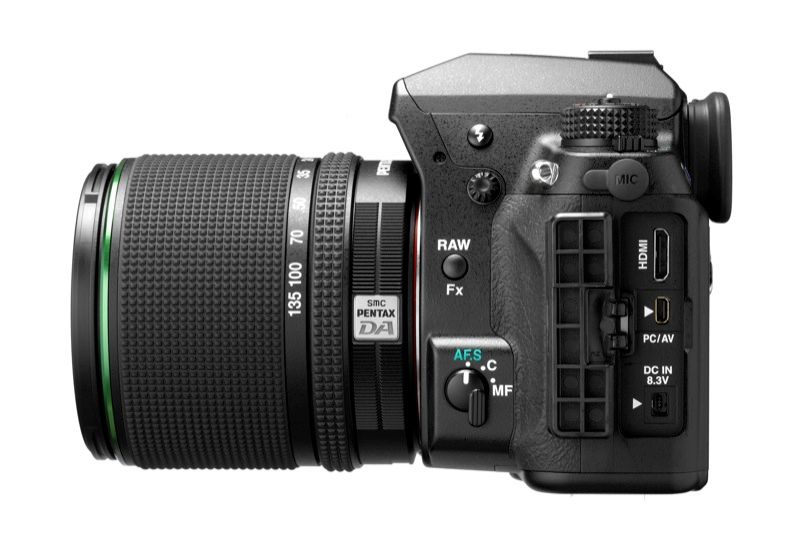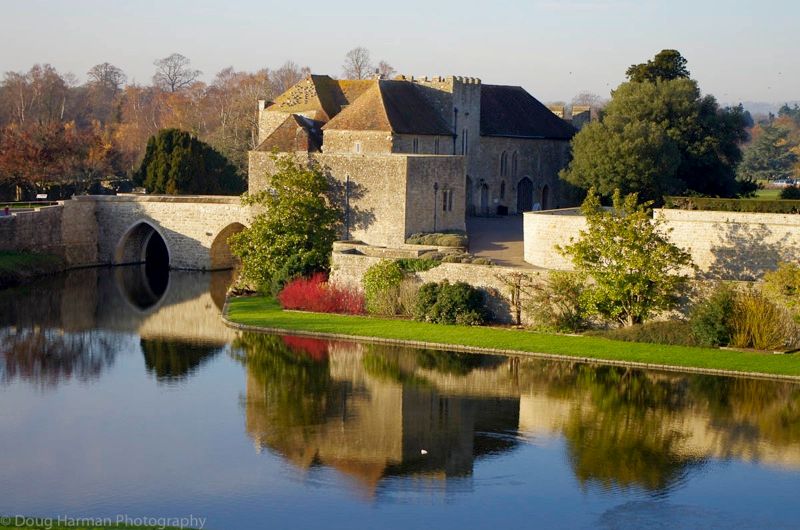Pentax’s K-5 DSLR is its new semi-pro model built around the Pentax K-7 top end model. Like that model, the K-5 has a host clever kit for the high-end or advanced amateur including some neat improvements and an excellent overall specification and huge range of compatible Pentax K-mount lenses; its ruggedised body and lens means the K-5 is a very good camera indeed.
Our quick take
The Pentax K-5 is very similar to the K-7 overall and that’s because that camera is very good; the K-5 brings a new sensor and new features to the party that make it an even more rounded camera in our view. A “proper” manual (rather than a PDF on CD-ROM) helps to get to grips with many of the camera’s features and like the camera this shows Pentax’s attention to detail.
The power of some of the features included here such as the focus calibration for older Pentax K-mount lenses and the WB assignment from already captured images will only fully reveal their power as you realise their usefulness, but suffice to say this is a superbly specified system camera that can properly bridge the gap between amateur and enthusiast and professional but in a tough, relatively compact body.
If you are looking to upgrade from a compact, you have owned a Pentax before or have Pentax lenses of yore and want to buy an up-to-date DSLR, or you simply want to buy a cracking camera that will shoot just about anything you can through at it out of the box, then you’d be hard pressed to find a better DSLR than the Pentax K-5.
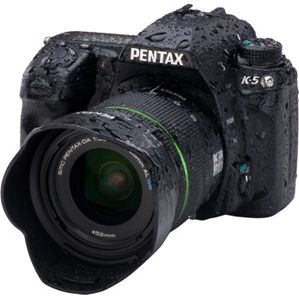
Pentax K-5 - 4.5 / 5
| FOR | AGAINST |
|---|---|
|
|
Key competitors for this market sector include Olympus’ new E-5, the Nikon D7000 and D300s and Canon’s EOS 60D. To that end the K-5 is one tough hombre with a weather proofed body inherited from its top end sibling, the K-7, to which it appears to be identical but its 16.3-megapixel sensor is actually the same as that found in both Sony’s A55 and Nikon’s D7000 models. The K-5 has, however, a few new and interesting tweaks over the K-7 that make it stand out and compete more effectively against the competition.
The most notable of these is an improved sensitivity range, which now stretches from ISO 80 to ISO 51200. Combine that with a much-improved SAFOX IX auto focusing set up and a 77-zone matrix metering system and suddenly the K-5 starts to look every bit the semi-pro model it’s meant to be.
The inclusion of a 1080p Full HD movie mode is probably more or less what you’d expect from today's DSLRs but is able to shoot at 25fps, what’s more impressive, however, particularly given the high resolution sensor, is the (up to) 7fps stills shooting mode.
The K-5 weighs in at 660g (without battery or SD/SDHC memory card) and with dimensions of 97 x 131 x 73mm; it has the same dust, weather and cold proofed bodywork as found on the K-7. It has a stainless steel and magnesium and steel alloy body and a shutter designed for “100,000 releases” says Pentax. In the hand therefore, it feels nicely weighted and very strong.
The sculpted hand grip provides bags of grip too thanks to its rubberised surfaces, giving the overriding impression the K-5 is as capable of cracking Christmas walnuts with a single tap as it will be at taking stunning images with a single snap, no matter what the weather conditions.
To activate the camera there’s a Nikon-alike on/off switch that surrounds the nicely weighted shutter release, itself sat in front of a large (back lit) data LCD and ISO and exposure compensation buttons. Over the other side of the hot shoe and rather underpowered pop-up flash is a neat mode dial and nestled below, the metering mode switch.
A locking button on the top of the mode dial prevents accidental changes in use and while a little fiddly to use, it is all so well put together it just helps ooze handling confidence. Here you can choose between a suite of creative modes including Bulb, X-Sync flash and a combined Shutter and Aperture Priority mode that adjusts the ISO to ensure you get an as metered exposure.
The usual Program, Shutter and Aperture Priority and Manual modes are there too as is the green point and shoot mode and the Movie shooting mode. But more on these shortly.
On the back we find the 100% field-of-view, 0.92x magnification optical viewfinder and this is both bright a crisp with a sliding dioptre adjustment. The 100% field of view means what you see through the finder is exactly what will appear in the photo you take and so you (in theory at least) should never suffer from unwanted elements creeping into your shots, which is a big bonus indeed.
The superbly detailed and clear 3-inch colour screen boasts 920,000 dots providing more than enough detail for critical focus assessment and is okay to use for both Live View (LV) and when assessing settings or in menus in bright conditions.
Other controls include the LV button AF selection and activation controls plus controls for the impressive self timer/drive modes, white balance (WB), flash and capture modes the latter includes adjustable settings for bright, monochrome, natural and portrait modes among others.
A central “OK” button selects choices you make in the menu button at the bottom of the back plate alongside which sits the Info button. Here you can fire up a range of display choices including direct access controls over camera settings, a clever auto level head up display or just information on current camera settings.
The direct access system is navigated using the four-way jog buttons and OK button so perfectly sensible, ditto menus and settings within menus, all are adjusted via the four-way jog buttons.
We used the K-5 in cold temperatures, around -2 on a day’s shoot at Leeds Castle in Kent, for example, but the K-5 can operate without any problems in temperatures down to -10, according to Pentax and this is something of great importance for battery life as the cold affects that more than almost anything else. Needless to say, the battery was fine and is still going strong on it’s first full charge and after over 300-shots.
While the K-5 is aimed at the more advanced user, it does not feel too intimidating, even though it sports a lot of external controls (25 in all) many of which have multiple uses depending on the mode you’re in or what you’re trying to adjust. But the layout is good and logical so you never have the feeling you’ll be overwhelmed by the task of camera set-up.
Thankfully the K-5 has neat explanations for custom settings within its menus, which helps. The info display also provides icons and text for each set-up option, this helps familarise you with the controls quickly too and there are five user programmable settings as well, so you can effectively set the camera five different ways for oft used settings depending on what you’re shooting.
The SMC Pentax-DA 18-55mm standard zoom lens used for this test is, well, standard fare in terms of its features, though build matches the bodywork being protected from dirt and water ingress and it has special easy clean coatings on the glass.
But the focal range is really only good for very general shooting chores and the F/3.5-F/5.6 aperture range is slow, so, if you’re serious about your photography you’ll need to treat this lens as a “getting started” optic only, the fact that the K-5 can use all Pentax K-Mount optics however, means there’s a huge range of older and new lenses out there making it a massively versatile system indeed.
The camera’s relative complexity is largely hidden well until you get into the menus, whereupon a lot of the features at your disposal reveal themselves either in the four banks of custom settings or through the many possible set-up options for items such as highlight and shadow compensation adjustments, HDR snapping or the digital filters and extended bracketing options, which include bracketing for everything from the WB to saturation, hue and contrast among others.
The digital filters are fun digital processes the camera can perform such as apply a retro look to a shot, applying a soft focus effect, a toy camera “look” and other fun stuff such as isolating specific colours to a starburst or fisheye effect.
Disappointingly none of these features (or the cross processing effect of the HDR capture modes) can be used if shooting in either the Pentax PEF RAW or Adobe DNG RAW modes, even if combining them with JPEGs!
Now, we can understand this thinking to a degree because if shooting RAWs you would not want to apply a digital effect to it, otherwise it is then not a RAW file. But why not apply the effect to a JPEG and shoot a RAW too, just as you can when shooting on an Olympus, such as the E30? On an Olympus DSLR you can combine Olympus Art Filters (their version of Pentax’s digital filters) as JPEGs with RAW.
Apart from the usual array of shooting options mentioned earlier, the K-5 has a couple of other modes that are both unusual (at least on non-Pentax gear) and useful. The first is the Aperture and Shutter priority shooting mode and the second is Sensitivity Priority mode. The latter will select an appropriate aperture and shutter speed combo for the ISO you’ve set, whom you can shift in half or 1/3rd of a stop steps via the rear control dial.
This mode allows you to quickly set an ISO (say you need to consider the impact of any potential noise issues (more on noise later) without having to tinker in menus which is ideal in rapidly changing lighting, for example.
In Shutter and Aperture Priority the opposite happens; the camera picks an ISO based on your shutter and aperture settings, and this is very cool as it provides a third way (the ISO sensitivity) to control exposure and Pentax is, we believe, still the only camera manufacturer that provides this useful and powerful feature, something that first appeared on Pentax’s K10D and then the K20D.
There is so much in this camera that is good yet there are another couple of standouts that include the excellent focus confirmation system the camera employs when shooting LV shots. Once the camera has focused on the scene it instantly activates an enlarged section of the scene that has been focused upon. This lets you quickly check it has picked the correct part of the scene and check it will be sharply rendered too.
Yes it ads a modicum of time to the focus process but we found it useful and a time saver overall in not having to go back and take another shot, particularly useful for portraits and/or macro work to give a couple of examples.
In LV mode, the Info button can also be used to magnify the subject by six times too, this is great when undertaking tripod mounted work and as indicated earlier, in LV mode you can adjust most of the main shooting controls, including aperture, exposure compensation and ISO all directly from the 3-inch display too.
One of the other key aspects of this Pentax is of course its ability to shoot Full HD movies with sound; the fourth Pentax to shoot HD movies it is, nevertheless, the first to do it at 1080p.
The camera can record at up to 25fps and shoots in the Motion JPEG AVI format, able to create clips of 25-minutes in length or around 4GB. Downsides include only mono sound recording, but there is a socket for an external stereo microphone, which you’ll have to buy separately. Unfortunately, you’ll also need to ensure the camera’s mode dial in set to the Movie mode position before you can record a movie, unlike many of the camera’s competing models, which can start recording at the press of a button.
Adding further to the movie making complexity, you’ll also need to either press the AF button on the back or half press the shutter release to carry out focusing beforehand too, then fully depress it to start recording. A further press of the shutter release ends recording. You’ll have to manually focus if you need to change the focus point while shooting (Nikon’s D7000 model has live AF during movie recording) so pre-focusing is the key here and certainly not the most user-friendly option.
Aperture settings are fixed during recording (unless you use a lens with a separate aperture ring, rather than the body integral control) and you cannot change shutter speeds mid-shoot either so you rely entirely on the camera’s auto-exposure and metering system to get it right.
Under a weatherproofed cover is space for external storage on the handgrip side of the camera, below is the equally weather protected cable release port. On the opposite side of the camera is large ruggedised flap that hides the AV out, DC in and HDMI ports, the latter for direct connection to a HD TV with the (optional) HDMI mini-cable, it a shame that’s not included in the kit given the price you’re paying.
One of the other features we really think is useful given the camera’s compatibility with older optics is a feature that could be a bit of a bridesmaid given all the other kit to shout about. It is the AF Adjustment, housed deep within the custom settings.
Sounds boring but we have to disagree and here’s why. If you own older or pre-digital Pentax lenses and you want to use them on the K-5 but you’re not sure they’ll focus correctly on a DSLR, this feature provides a powerful tool to set-up and ensure they focus correctly. You can alter the focus point of each lens using a focus target for critical assessment, then test it again and repeat until you’ve adjusted the lens to focus properly, saving time (and probably money) in not having to send the camera and lens to be calibrated by the manufacturers and saves on buying new optics too.
The camera is responsive and particularly fast when focusing thanks to the new 11-zone SAFOX IX AF setup and you can keep shooting at 7fps. But slightly disappointing is the time it takes to write a RAW file, around 2 seconds on my tests (with a JPEG for good measure) so you can continuously shoot 20 RAWs or 22 JPEGs which is still rather good given the 16-megapixel resolution files you’ll be buffering over to the card with a RAW around 15.5MB and high quality JPEGs of around 6.6MB each it is no mean feat.
Once you’ve captured images, the K-5 also has a broad range of playback options that are particularly useful, you can compare two images side-by-side, with a zoom mode while you have RAW development tools as well for JPEG or TIFF format copies of the RAW all done in-camera.
You can set-up an index print from up to 36-shots while a very useful feature is one that allows you to set the camera’s WB to an image you’ve already recorded. The Save as Manual WB mode is a powerful mode and one that can be great for helping sort out any colour casts derived from mixed lighting situations, for example.
And so we arrive at the nitty gritty of any camera test, the image assessment. Having used the K-5 for a few weeks now, we can report we’re very impressed. Noise at higher ISOs is well controlled, in fact apart from some slight mottling at ISO 800; noise does not really appear until you get to ISO 1600. At ISO 3200 and 6400 noise is detectable but not intrusive viewed on screen.
Viewed at 100% on screen and images shot at ISO 12800, 25600 and 51200 have noise issues running from bad to very bad indeed and while it’s nice to be able to shoot in near darkness, the images are not much to write home about we’re afraid.
Metering performance is good, although we found the 77-segment setup underexposes a little, switch to centre-weighted and it is less so.
Having said that, colour and saturation are very good across the board, though JPEGs seem quite heavily saturated at the default “Natural” setting. The level of detail is very good indeed partly due to the new 16.3-megapixel APS-C CMOS sensor although it’s worth saying here, better lenses (than the 18-55mm standard zoom supplied and tested here) will glean even finer levels of detail and presumably will also help reduce the amount blue and red fringing evident on some high contrast parts of our images, the latter being just about the only demerit we can think of in this area.
To recap
The Pentax K-5 is a comprehensively specified professional or semi-professional DSLR that is capable of superb results, it is also one of the best examples of such a camera we’ve had to tinker with; image quality, low noise and superbly useful features make the camera strong proposition for anyone not already locked into a system by another maker and it gives all its rivals a real run for their money. Buy it!

